Crocus care tips for September

Overwintering not-so-hardy Shrubs and Climbers
Many so called 'hardy' plants are actually only borderline hardy in colder regions and exposed gardens. Even plants with a reputation for being really tough can be vulnerable at certain times. In fact hardy plants that are not fully established can be damaged or killed in a prolonged cold spell in exposed gardens, while new growth put on in early spring during a period of mild weather is vulnerable to scorch if the weather turns cold. You can however use a range of techniques to protect plants. If you grow plants in containers, you can stop them from freezing solid in winter by wrapping the pots in bubble wrap and moving them to a sheltered spot. Covering the top-growth of susceptible plants and those of borderline hardiness with a double-layer of garden fleece will also offer protection, but don't forget to make sure that you leave access to water plants over the winter months.
Here’s our plant-by-plant survival guide for those growing in the ground:
Abelia (borderline hardy)
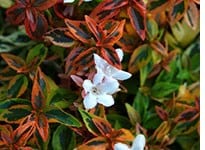 In autumn, after flowering, lightly trim back the flowered shoots to retain a neat and tidy shape. In cold or exposed gardens, protect vulnerable specimens with an enclosure made from windbreak netting that is lined with garden fleece. Protect roots with an insulating mulch. Young plants are worth protecting from cold winds and severe frosts in other areas too. Remove any dead or damaged wood in April.
In autumn, after flowering, lightly trim back the flowered shoots to retain a neat and tidy shape. In cold or exposed gardens, protect vulnerable specimens with an enclosure made from windbreak netting that is lined with garden fleece. Protect roots with an insulating mulch. Young plants are worth protecting from cold winds and severe frosts in other areas too. Remove any dead or damaged wood in April.
 Once established, Japanese maples will survive in all but the coldest and most exposed gardens. However, new growth in spring is vulnerable to being scorched by cold winds and late frosts. In cold or exposed gardens, protect vulnerable specimens with an enclosure made from windbreak netting that is lined with garden fleece. New plants should be protected from the worst winter weather in all areas.
Once established, Japanese maples will survive in all but the coldest and most exposed gardens. However, new growth in spring is vulnerable to being scorched by cold winds and late frosts. In cold or exposed gardens, protect vulnerable specimens with an enclosure made from windbreak netting that is lined with garden fleece. New plants should be protected from the worst winter weather in all areas.
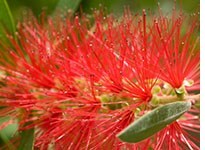 Bottle brush can survive outside in mild areas, but flowers more reliably if grown in a container and given winter protection in a frost-free greenhouse or conservatory. Outside, protect specimens with a sleeve made from a double layer of garden fleece. Use soft string to keep in place. Young plants are more vulnerable so are worth protecting during cold snaps even in normally mild areas. Wall-trained specimens should be insulated from the cold by spreading a sheet of fine-mesh netting over the plants and stuffing it with insulating material, such as straw or dry leaves. Alternatively, you could drape the plants with a double layer of garden fleece. Make sure you secure the netting along all sides to prevent it blowing about in windy weather.
Bottle brush can survive outside in mild areas, but flowers more reliably if grown in a container and given winter protection in a frost-free greenhouse or conservatory. Outside, protect specimens with a sleeve made from a double layer of garden fleece. Use soft string to keep in place. Young plants are more vulnerable so are worth protecting during cold snaps even in normally mild areas. Wall-trained specimens should be insulated from the cold by spreading a sheet of fine-mesh netting over the plants and stuffing it with insulating material, such as straw or dry leaves. Alternatively, you could drape the plants with a double layer of garden fleece. Make sure you secure the netting along all sides to prevent it blowing about in windy weather.
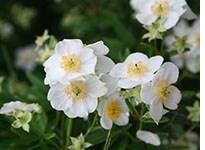 This summer-flowering, evergreen shrub should be grown against a sheltered, south or west-facing wall or fence and protected from cold, drying winds. In colder areas, insulate from the cold by spreading a sheet of fine-mesh netting over the plants and stuffing it with insulating material, such as straw or dry leaves. Alternatively, you could drape the plants with a double layer of garden fleece. Make sure you secure the netting along all sides to prevent it blowing about in windy weather.
This summer-flowering, evergreen shrub should be grown against a sheltered, south or west-facing wall or fence and protected from cold, drying winds. In colder areas, insulate from the cold by spreading a sheet of fine-mesh netting over the plants and stuffing it with insulating material, such as straw or dry leaves. Alternatively, you could drape the plants with a double layer of garden fleece. Make sure you secure the netting along all sides to prevent it blowing about in windy weather.
 Although well-established plants can survive reliably in most gardens, it’s a good idea to protect young plants during cold snaps. This is especially true if your soil is cold and wet as well.
Although well-established plants can survive reliably in most gardens, it’s a good idea to protect young plants during cold snaps. This is especially true if your soil is cold and wet as well.
 Californian lilacs thrive in a sunny, sheltered site, but can struggle elsewhere until well established. Young plants are particularly vulnerable to cold, drying winds so protect exposed plants with a double layer of garden fleece during windy cold snaps. Tender varieties need even more tlc - insulate from the cold by spreading a sheet of fine-mesh netting over the plants and stuffing it with insulating material, such as straw or dry leaves. It’s also worth insulating the root area with a thick layer of loose organic mulch.
Californian lilacs thrive in a sunny, sheltered site, but can struggle elsewhere until well established. Young plants are particularly vulnerable to cold, drying winds so protect exposed plants with a double layer of garden fleece during windy cold snaps. Tender varieties need even more tlc - insulate from the cold by spreading a sheet of fine-mesh netting over the plants and stuffing it with insulating material, such as straw or dry leaves. It’s also worth insulating the root area with a thick layer of loose organic mulch.
 Although well-established plants can survive reliably in most gardens, it’s a good idea to insulate the root area of young plants with a loose organic mulch during cold snaps.
Although well-established plants can survive reliably in most gardens, it’s a good idea to insulate the root area of young plants with a loose organic mulch during cold snaps.
Chamaerops humilis (half hardy)
The dwarf fan palm can be grown as a garden plant in mild areas. It is best grown in a container and given winter protection in a frost-free greenhouse or conservatory. Outside, protect specimens with a sleeve made from a double layer of garden fleece. Use soft string to keep it in place. Young plants are more vulnerable so are worth protecting during cold snaps even in normally mild areas.
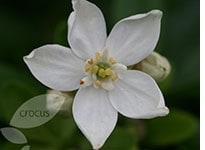 Hardy in all but the coldest areas, Mexican orange blossom is vulnerable to cold winds when young. Protect exposed plants with a double layer of garden fleece during windy cold snaps and insulate the root area with a loose organic mulch. Remove any frost-damaged stems to the base.
Hardy in all but the coldest areas, Mexican orange blossom is vulnerable to cold winds when young. Protect exposed plants with a double layer of garden fleece during windy cold snaps and insulate the root area with a loose organic mulch. Remove any frost-damaged stems to the base.
Cistus (frost hardy)
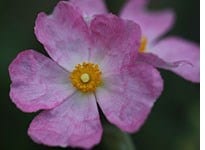 Rock roses are vulnerable during severe freezing conditions in northern gardens and can be damaged by cold winds elsewhere. Protect exposed plants with a double layer of garden fleece during windy cold snaps.
Rock roses are vulnerable during severe freezing conditions in northern gardens and can be damaged by cold winds elsewhere. Protect exposed plants with a double layer of garden fleece during windy cold snaps.
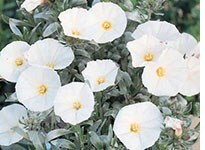 Shrubby convolvulus are prone to rotting in wet areas, but can be sheltered when young using an open-ended cloche. In areas with cold, wet winters it is best grown in a container.
Shrubby convolvulus are prone to rotting in wet areas, but can be sheltered when young using an open-ended cloche. In areas with cold, wet winters it is best grown in a container.
 The cabbage palm is an ideal specimen plant for a sunny, protected border or patio. In frost-prone areas, grow it in a large tub and move it somewhere sheltered or preferably frost–free over the winter months. Alternatively, protect specimens with a sleeve made from a double layer of garden fleece. Use soft string to keep in place. In spring when new growth appears and all danger of hard frosts has passed cut back frost-damaged branches to just above the newly formed shoots.
The cabbage palm is an ideal specimen plant for a sunny, protected border or patio. In frost-prone areas, grow it in a large tub and move it somewhere sheltered or preferably frost–free over the winter months. Alternatively, protect specimens with a sleeve made from a double layer of garden fleece. Use soft string to keep in place. In spring when new growth appears and all danger of hard frosts has passed cut back frost-damaged branches to just above the newly formed shoots.
Cytissus battandieri (frost hardy)
Pineapple brooms can survive outside in mild areas, but flowers more reliably if protected overwinter with a sleeve made from a double layer of garden fleece. Use soft string to keep it in place. Young plants are more vulnerable so are worth protecting during cold snaps even in normally mild areas. Wall-trained specimens should be insulated from the cold by draping with a double layer of garden fleece secured with soft string.
Eccremocarpus scaber (borderline frost hardy)
The Chilean glory flower needs protecting over the winter months in all but the mildest gardens. Better still, grow it in a frost-free greenhouse or conservatory. Wall-trained specimens overwintered outside should be protected from the cold by spreading a sheet of fine-mesh netting over the plants and stuffing it with insulating material, such as straw or dry leaves. Make sure you secure the netting along all sides to prevent it blowing about in windy weather.
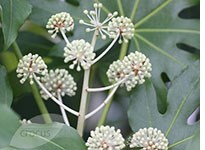 It may look as tough as old boots, but this Japanese aralia is not reliably hardy in cold or exposed gardens. Protect plants from cold, drying winds, especially when young. The best way to do this is to plant it in the protection of other shade-loving shrubs and trees in a mixed woodland-edge planting. In cold or exposed gardens, protect vulnerable specimens with an enclosure made from windbreak netting that is lined with garden fleece. Protect roots with an insulating mulch.
It may look as tough as old boots, but this Japanese aralia is not reliably hardy in cold or exposed gardens. Protect plants from cold, drying winds, especially when young. The best way to do this is to plant it in the protection of other shade-loving shrubs and trees in a mixed woodland-edge planting. In cold or exposed gardens, protect vulnerable specimens with an enclosure made from windbreak netting that is lined with garden fleece. Protect roots with an insulating mulch.
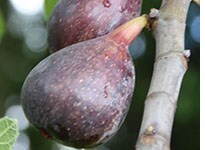 Figs have become a common sight in city and southern gardens. They are hardy and will produce a reliable crop if grown against a sheltered sunny wall. Young plants are more vulnerable so are worth protecting during cold snaps even in normally mild areas. Wall-trained specimens can be insulated from the cold by draping with a double layer of garden fleece secured with soft string. Prune in spring when all chance of frost has past by removing any frost damaged stems.
Figs have become a common sight in city and southern gardens. They are hardy and will produce a reliable crop if grown against a sheltered sunny wall. Young plants are more vulnerable so are worth protecting during cold snaps even in normally mild areas. Wall-trained specimens can be insulated from the cold by draping with a double layer of garden fleece secured with soft string. Prune in spring when all chance of frost has past by removing any frost damaged stems.
Fremontodendron ‘California Glory' (frost hardy)
This vigorous evergreen climber is best grown against a warm sunny wall, sheltered from cold, drying winds. In all but mild gardens, wall-trained specimens should be insulated from the cold by draping with a double layer of garden fleece secured with soft string.
Fuchsia (borderline hardy)
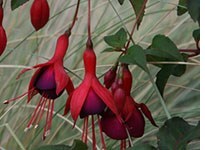 Although so-called hardy varieties can be left outside overwinter, the top growth is likely to be cut back by frosts. So unless you garden in a mild area, it’s worth trimming it in autumn and laying the trimmings over the crown to provide an insulating layer against severe frost. Also protect roots with an insulating mulch.
Although so-called hardy varieties can be left outside overwinter, the top growth is likely to be cut back by frosts. So unless you garden in a mild area, it’s worth trimming it in autumn and laying the trimmings over the crown to provide an insulating layer against severe frost. Also protect roots with an insulating mulch.
Griselinia littoralis (borderline hardy)
Hardy in all but the coldest areas, Griselinia is vulnerable to cold winds when young. Protect exposed plants with a double layer of garden fleece during windy cold snaps and insulate the root area with a loose organic mulch.
Hebe (mostly hardy)
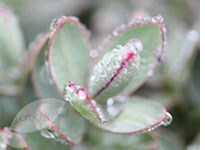 Small leaved varieties are generally hardy, but the popular ‘Red Edge’ is only frost hardy and so needs winter protection from cold, drying winds. Protect exposed plants with a double layer of garden fleece during windy cold snaps and insulate the root area with a loose organic mulch. Remove any frost-damaged stems in spring.
Small leaved varieties are generally hardy, but the popular ‘Red Edge’ is only frost hardy and so needs winter protection from cold, drying winds. Protect exposed plants with a double layer of garden fleece during windy cold snaps and insulate the root area with a loose organic mulch. Remove any frost-damaged stems in spring.
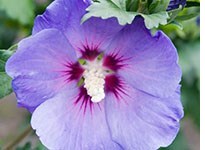 Although well-established plants can survive reliably in most gardens, it’s a good idea to protect young plants during cold snaps with a double layer of garden fleece. Also, insulate the root area with a loose organic mulch. Other hibiscus are less hardy, so may need more protection.
Although well-established plants can survive reliably in most gardens, it’s a good idea to protect young plants during cold snaps with a double layer of garden fleece. Also, insulate the root area with a loose organic mulch. Other hibiscus are less hardy, so may need more protection.
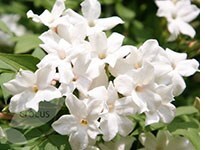 Summer jasmine is not as hardy as winter jasmine so needs protection in all but the mildest of gardens. Protect trained young plants during cold snaps with a curtain-like double layer of garden fleece, and insulate the root area with a loose organic mulch.
Summer jasmine is not as hardy as winter jasmine so needs protection in all but the mildest of gardens. Protect trained young plants during cold snaps with a curtain-like double layer of garden fleece, and insulate the root area with a loose organic mulch.
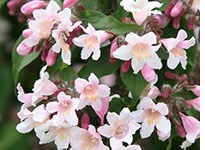 Although well-established plants can survive reliably in most gardens, it’s a good idea to insulate the root area of young plants with a loose organic mulch as added protection during cold snaps.
Although well-established plants can survive reliably in most gardens, it’s a good idea to insulate the root area of young plants with a loose organic mulch as added protection during cold snaps.
 In cold or exposed gardens, protect vulnerable bay specimens with a sleeve made from a double layer of garden fleece. Use soft string to keep in place. Protect roots with an insulating mulch.
In cold or exposed gardens, protect vulnerable bay specimens with a sleeve made from a double layer of garden fleece. Use soft string to keep in place. Protect roots with an insulating mulch.
Lavatera olbia (hardy)
Well-established plants should survive reliably in most gardens, but it’s a good idea to insulate the root area of young plants with a loose organic mulch as added protection during cold snaps. In exposed areas shorten branches by up to one half in autumn to minimise the risk of wind-rock damage.
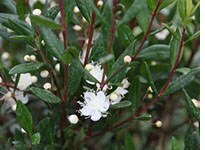 Myrtle needs protection from cold drying winds. In cold or exposed gardens, use a double layer of garden fleece, secured with soft string. Protect roots with an insulating mulch.
Myrtle needs protection from cold drying winds. In cold or exposed gardens, use a double layer of garden fleece, secured with soft string. Protect roots with an insulating mulch.
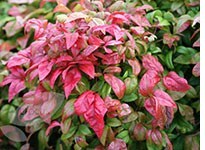 Sacred bamboo can survive unaided outside in mild areas, but in cold and exposed gardens protected overwinter with a double layer of garden fleece, secured with soft string. Young plants are more vulnerable so are worth protecting during cold snaps even in normally mild areas. Protect roots with an insulating mulch.
Sacred bamboo can survive unaided outside in mild areas, but in cold and exposed gardens protected overwinter with a double layer of garden fleece, secured with soft string. Young plants are more vulnerable so are worth protecting during cold snaps even in normally mild areas. Protect roots with an insulating mulch.
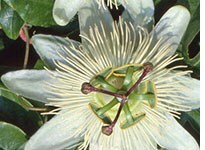 Passion flowers can survive outside in mild areas, but flowers more reliably if protected overwinter with a curtain-like double layer of garden fleece. Use soft string to keep in place. Young plants are more vulnerable so are worth protecting during cold snaps even in normally mild areas. Any frost damaged stems should be pruned back in spring.
Passion flowers can survive outside in mild areas, but flowers more reliably if protected overwinter with a curtain-like double layer of garden fleece. Use soft string to keep in place. Young plants are more vulnerable so are worth protecting during cold snaps even in normally mild areas. Any frost damaged stems should be pruned back in spring.
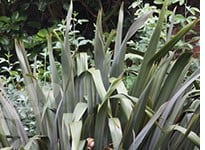 New Zealand flax makes a magnificent feature plant for a large, sunny, garden, protected from cold, drying winds. One of the largest varieties, it thrives particularly well in warm, coastal sites. Elsewhere, protect with a sleeve made from a double layer of garden fleece. Use soft string to keep it in place. Young plants and variegated varieties are more vulnerable so are worth protecting during cold snaps even in normally mild areas.
New Zealand flax makes a magnificent feature plant for a large, sunny, garden, protected from cold, drying winds. One of the largest varieties, it thrives particularly well in warm, coastal sites. Elsewhere, protect with a sleeve made from a double layer of garden fleece. Use soft string to keep it in place. Young plants and variegated varieties are more vulnerable so are worth protecting during cold snaps even in normally mild areas.
 Protect plants from cold, drying winds, especially when young. In cold or exposed gardens, protect with an enclosure made from windbreak netting that is lined with garden fleece. Protect roots with an insulating mulch.
Protect plants from cold, drying winds, especially when young. In cold or exposed gardens, protect with an enclosure made from windbreak netting that is lined with garden fleece. Protect roots with an insulating mulch.
Phygelius capensis (frost hardy)
Cape figwort needs protecting over the winter months in all but the mildest gardens if you want the top-growth to survive. In frost-prone areas provide a dry winter mulch. Cut the flowered stems back to the base in spring.
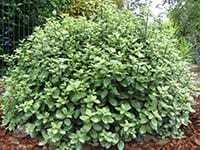 This evergreen makes a handsome informal hedge for a sunny coastal garden, sheltered from cold, drying winds. In cold or exposed gardens, protect vulnerable specimens with an enclosure made from windbreak netting that is lined with garden fleece. Protect roots with an insulating mulch. Young plants are worth protecting from cold winds and severe frosts in other areas too. Remove any dead or damaged wood in April.
This evergreen makes a handsome informal hedge for a sunny coastal garden, sheltered from cold, drying winds. In cold or exposed gardens, protect vulnerable specimens with an enclosure made from windbreak netting that is lined with garden fleece. Protect roots with an insulating mulch. Young plants are worth protecting from cold winds and severe frosts in other areas too. Remove any dead or damaged wood in April.
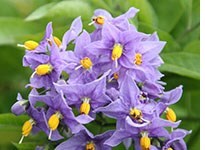 This vigorous scented climber is perfect for covering a sunny, sheltered wall or fence. In cold and exposed gardens, wall-trained specimens should be insulated from the cold by draping with a double layer of garden fleece secured with soft string. Protect roots with an insulating mulch.
This vigorous scented climber is perfect for covering a sunny, sheltered wall or fence. In cold and exposed gardens, wall-trained specimens should be insulated from the cold by draping with a double layer of garden fleece secured with soft string. Protect roots with an insulating mulch.
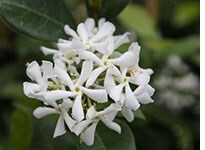 It is best grown against a warm, sunny wall in milder areas. Protect on cold nights with a curtain made from a double layer of garden fleece and protect roots with an insulating mulch. In frost prone areas, grow in pots of loam-based potting compost, such as John Innes No2 and move to a frost-free spot in winter.
It is best grown against a warm, sunny wall in milder areas. Protect on cold nights with a curtain made from a double layer of garden fleece and protect roots with an insulating mulch. In frost prone areas, grow in pots of loam-based potting compost, such as John Innes No2 and move to a frost-free spot in winter.

































